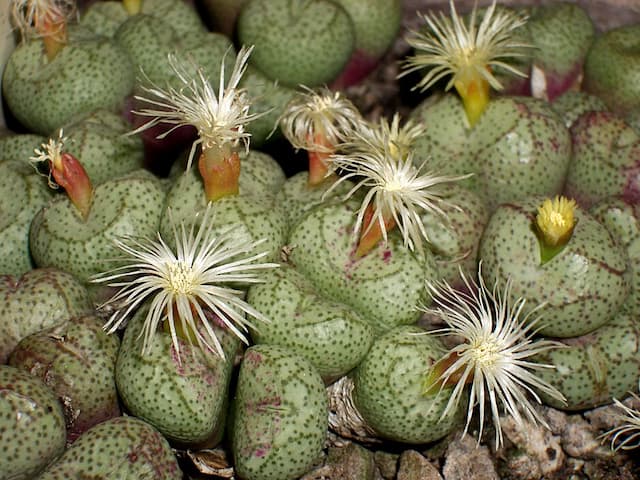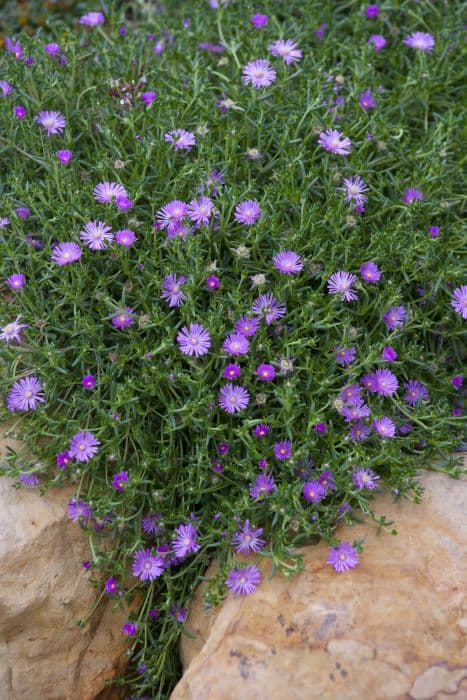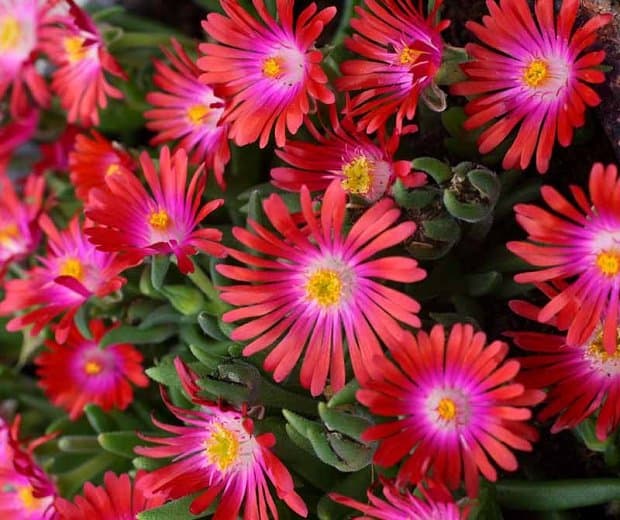Hardy Ice Plant Delosperma nubigenum

ABOUT
Delosperma nubigenum, commonly known as Hardy Yellow Ice Plant, is a succulent with a mat-forming growth habit. Its appearance is characterized by fleshy, bright green leaves that are small, cylindrical, and often have a glistening quality, reminiscent of ice crystals, hence its common name. The plant's leaves are tightly packed together, creating a dense carpet of greenery. During its flowering season, the Hardy Yellow Ice Plant produces cheerful, daisy-like blooms that are a vibrant shade of yellow. These flowers typically have many delicate petals radiating from a central disc, providing a bold contrast against the green foliage. The blooms are eye-catching and are known to attract various pollinators such as bees and butterflies. The overall impression of the Hardy Yellow Ice Plant is one of a lush, low-growing ground cover that provides a pop of color with its blooms while maintaining visual interest even when not in flower thanks to its shiny leaves. It is popular in gardens for its drought-tolerant qualities and is often used in rock gardens, on slopes, or in alpine plantings where it can add texture and a splash of color without overshadowing other plantings.
About this plant
 Names
NamesFamily
Aizoaceae
Synonyms
Hardy Yellow Ice Plant, Yellow Ice Plant
Common names
Mesembryanthemum nubigenum
 Characteristics
CharacteristicsLife cycle
Perennials
Foliage type
Evergreen
Color of leaves
Green
Flower color
Yellow
Height
0.16 feet (5 cm)
Spread
2 feet (60 cm)
Plant type
Succulent
Hardiness zones
6
Native area
South Africa
Benefits
 General Benefits
General Benefits- Drought Tolerance: Hardy Ice Plant has a high capacity to retain water, making it ideal for xeriscaping and water-wise gardens.
- Low Maintenance: Once established, Hardy Ice Plant requires minimal care, rarely needing fertilizer or pruning.
- Ground Cover: Quick-growing and mat-forming, it effectively covers bare spots, reduces soil erosion, and suppresses weeds.
- Cold Hardy: It can survive in colder climates, down to USDA hardiness zone 4.
- Attractive Flowers: Produces bright yellow flowers that add vibrant color to the landscape.
- Suitable for Rock Gardens: Its tolerance for poor soil makes it a perfect fit for rock gardens and alpine plantings.
- Soil Stabilization: Deep-rooting system helps stabilize slopes and disturbed soils.
- Pollinator-friendly: The flowers attract bees and other pollinators, supporting local ecosystems.
- Deer Resistant: Typically not favored by deer, which can be beneficial in areas with high deer populations.
- Seasonal Interest: Provides year-round interest with succulent leaves and seasonal blooms.
 Medical Properties
Medical PropertiesThis plant is not used for medical purposes.
 Air-purifying Qualities
Air-purifying QualitiesThis plant is not specifically known for air purifying qualities.
 Other Uses
Other UsesGroundcover: Delosperma nubigenum, commonly known as Hardy Ice Plant, is often used as a dense groundcover that can help prevent soil erosion and suppress weed growth.
Drought-tolerant landscaping: Due to its water retention capabilities, Hardy Ice Plant is ideal for xeriscaping or gardens in areas that experience water restrictions.
Rock gardens: It thrives in rocky, well-drained soils, making it a perfect addition to rock gardens where other plants may struggle to survive.
Lawn alternative: In regions with dry climates, Hardy Ice Plant can serve as a water-wise alternative to traditional grass lawns.
Living mulch: Its thick foliage can act as a living mulch, cooling the soil and retaining moisture during hot weather.
Green roofs: The plant's low-growing habit and drought resistance make it suitable for planting on green roofs, providing insulation and aiding in stormwater management.
Butterfly and bee garden: Hardy Ice Plant produces flowers that attract pollinators such as bees and butterflies, promoting biodiversity.
Container gardens: Due to its compact size, it can be grown in containers and can add color and texture to balconies or patios.
Crevice filler: Its ability to spread and grow in small spaces makes it an excellent plant for filling crevices in walls or walkways.
Edible ornamental: While not a common culinary ingredient, the plant's leaves are edible and can be used as a garnish or in salads for a unique texture.
Interesting Facts
 Feng Shui
Feng ShuiThe Hardy Ice Plant is not used in Feng Shui practice.
 Zodiac Sign Compitability
Zodiac Sign CompitabilityThe Hardy Ice Plant is not used in astrology practice.
 Plant Symbolism
Plant Symbolism- Resilience: Delosperma nubigenum, commonly known as Hardy Yellow Ice Plant, is known for its ability to survive in harsh, rocky environments, symbolizing the ability to endure difficult conditions and bounce back.
- Adaptability: The Hardy Yellow Ice Plant can survive in poor soils and is drought-tolerant, representing the quality of being able to adapt to less-than-ideal circumstances.
- Vitality: With its bright yellow flowers and succulent leaves, this plant embodies vitality and the vibrant energy of life.
- Cheerfulness: The sunny appearance of the Hardy Yellow Ice Plant's blooms is often associated with joy and positivity.
- Survival: The plant's capacity to conserve water and nutrients echoes the theme of survival and resourcefulness in challenging environments.
 Water
WaterThe plant commonly known as Hard Ice Plant needs to be watered sparingly. Overwatering can easily lead to root rot, so allow the soil to dry out completely between watering sessions. Water approximately once every two weeks during the growing season, providing about 0.25 gallons per watering for a medium-sized plant. In winter, reduce watering frequency, as the plant enters a dormant period. Ensure good drainage when watering to prevent water from accumulating at the base.
 Light
LightHard Ice Plant thrives in full sunlight and can tolerate high levels of direct exposure. Ideal growing conditions include a south-facing spot where the plant can receive at least six hours of sunlight per day. Avoid places with prolonged shade, as this can impede growth and flowering.
 Temperature
TemperatureThe Hard Ice Plant prefers warm temperatures and is hardy in USDA zones 5 through 9. It can survive temperature dips down to around -20 degrees Fahrenheit, but the ideal range for this succulent is between 60 and 80 degrees Fahrenheit. Extreme heat above 90 degrees Fahrenheit can stress the plant, so partial shade may be beneficial in very hot summer climates.
 Pruning
PruningPruning Hard Ice Plant helps to maintain its shape and encourage bushier growth. Deadhead spent flowers to promote further blooming and cut back any overgrown or dead stems in late winter or early spring. Pruning once a year is typically sufficient for this low-maintenance succulent.
 Cleaning
CleaningAs needed
 Soil
SoilThe best soil for Hardy Ice Plant (Delosperma nubigenum) is a well-draining mix like cactus or succulent potting soil with added perlite or pumice for aeration. Aim for a soil pH between 6.0 and 7.5, ensuring proper nutrient uptake and plant health. Additionally, provide a top dressing of gravel to mimic its natural, rocky habitat and prevent moisture buildup around the stem.
 Repotting
RepottingHardy Ice Plant should be repotted every 2-3 years or when it outgrows its current container. Choose a container only slightly larger than the previous one as a too-large pot can hold excess moisture, leading to root rot. Ensure the new pot has ample drainage holes.
 Humidity & Misting
Humidity & MistingHardy Ice Plant prefers a dry environment with low humidity typical of its native arid habitats. It is tolerant of indoor air conditions but does best with humidity levels below 60%. Avoid high humidity environments to prevent fungal diseases.
 Suitable locations
Suitable locationsIndoor
Place Hardy Ice Plant in a bright, sunny spot and ensure good air circulation.
Outdoor
Grow in full sun, well-drained soil; protect from excessive winter wetness.
Hardiness zone
6-8 USDA
 Life cycle
Life cycleDelosperma nubigenum, commonly known as Hardy Ice Plant, begins its life cycle as a seed that germinates in spring, when soil temperatures are warm enough to encourage growth. After germination, the seedling establishes a root system and starts to produce fleshy, succulent leaves in a ground-hugging rosette. As the plant matures, it spreads outwards through stems that root at the nodes to form a dense, mat-like ground cover. In late spring to summer, Hardy Ice Plant produces bright yellow, daisy-like flowers that open in the sunshine and attract pollinators. Following pollination, the flowers develop into small capsules that contain seeds, which are then dispersed by wind, water, or animals, ensuring the propagation of the species. Lastly, although it is a perennial, in colder climates, Delosperma nubigenum may die back in the winter, only to regrow from its root system with the return of warm weather.
 Propogation
PropogationPropogation time
Spring to summer
The most popular method of propagating the plant known as Ice Plant (Delosperma nubigenum) is through cuttings. This is often done during the warmer growing seasons of spring or early summer. To propagate by cuttings, one should snip off a healthy piece of the plant's stem, ideally about 3 to 5 inches (7.6 to 12.7 cm) long. After cutting, it's advisable to let the end callous over for a day or two to prevent rot. Once calloused, the cutting can be placed directly into well-draining soil. To encourage rooting, it's crucial to keep the soil consistently moist but not waterlogged. Roots typically begin to form within a few weeks, after which the new plant can be treated as an established Ice Plant.







![Ice plant [Fire Spinner]](/_next/image?url=https%3A%2F%2Fplants-admin.emdemapps.com%2Fimages%2Fplants%2F%2Fimages%2F604b54d98722a.png&w=640&q=75)

